These days, flexibility is key. While I used to be one of those people who would go to four different stores just to find one item, that’s obviously changed. Minimizing our time at the grocery store is important, as is adopting a “no-expectations” attitude when it comes to the items that will be waiting for you there. So, in the spirit of flexibility, I thought it might be nice to share a “recipe” that can be easily customized based on what you have on hand. It’s also comforting, flavorful, easy to make, and leftover-friendly (both in the sense that you can use up veggies or grains that are already cooked AND in the sense that it’s easy to make a LOT of this and eat it over a few days). I’m calling it freestyle fried “rice.”
“Rice” is in quotes because you can use just about any grain. My favorite is actually millet, or a mixture of rice and millet. The only grains you probably want to stay away from are the porridgy ones like teff, amaranth, and oats, as they won’t really give you that fried rice feel and are also strongly-flavored. This dish also works best with leftover (refrigerated) cooked grains, which is one reason I always make more than I need whenever I make a fresh grain as part of dinner. Even if I don’t end up making this freestyle “fried” rice, having a grain already prepped and ready to be reheated in the fridge means one component of a meal is already done!
In the spirit of freestyling, I’ve decided not to use measurements for this. It’s more of a general “how to” recipe that you can make using the guidelines below, your own intuitions, and your taste buds. (FYI, if you are interested in perfecting your cooking intuitions, my sibling, Rafael Natan, is offering sliding scale cooking lessons via Zoom. Rafael will help you use your taste buds and senses to create delicious meals suited to you and what you have available in your kitchen. Check it out!)
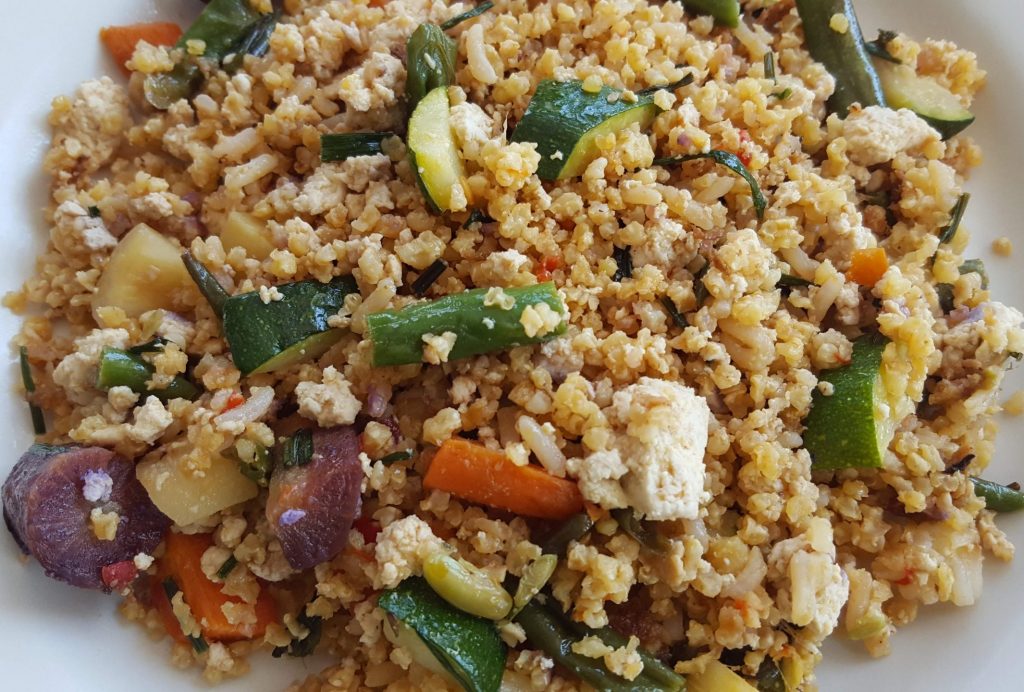
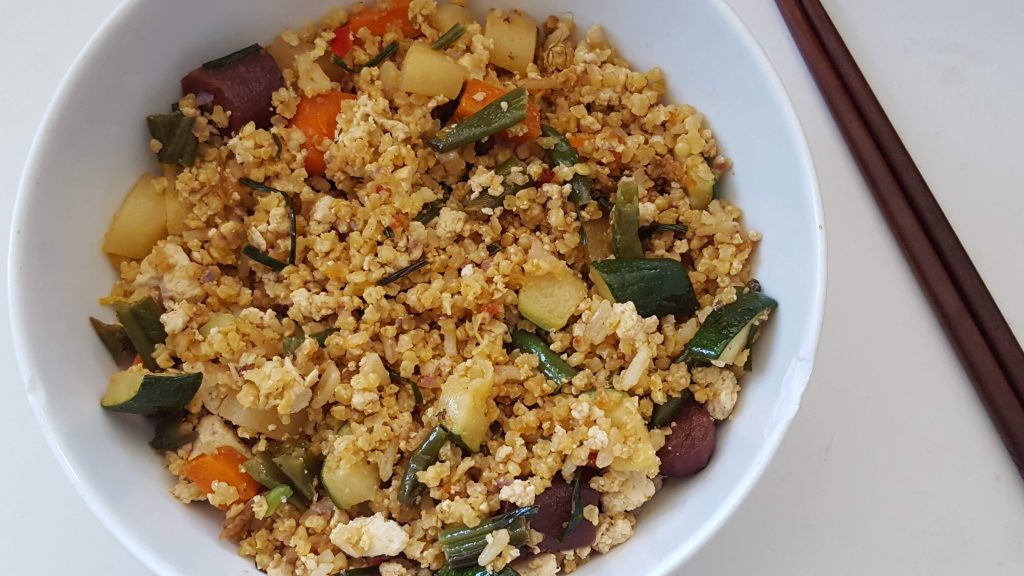
One note about the recipe:
-You’ll notice that I have this recipe categorized as peanut free, Low FODMAP, vegan, and dairy-free. Obviously, this depends on the ingredients you choose to use. Not all of the options mentioned in the guide below will meet these dietary requirements. For Low FODMAP, check the Monash app for “approved” veggies and amounts. For vegan, dairy-free, or peanut free, just don’t use animal products, dairy products, or peanuts :-)
Free-Style Fried “Rice”
Ingredients:
- A leftover cooked grain for the base of your “rice”
- A neutrally-flavored cooking oil (refined coconut, sunflower, safflower, canola, grapeseed, avocado, etc.)
- An assortment (1-4) of veggies: carrots, zucchini, broccoli, bok choy, spinach, pepper, green beans, peas, cabbage, and mushrooms are all good options. In fact, I’m having trouble thinking of veggies that won’t work here!)
- Protein: tofu, scrambled egg, or tempeh
- Butter (if possible) OR red palm oil OR regular old cooking oil
- Fresh ginger root, grated (optional, but delicious)
- Chives OR scallions OR onion AND/OR garlic (optional, but delicious)
- Flavorings: Preferably tamari, chili paste (or, if you don’t have it, red pepper flakes can work), and toasted sesame oil
- Not possible? Here are some other options:
- tamarind + peanut butter + lime + tamari
- tamari + nutritional yeast + something spicy
- chili paste + sesame oil + lots of salt
- hot sesame oil + lots of salt + lime
- etc., etc., etc.!!
- Not possible? Here are some other options:
Directions:
General tips:
- Don’t cook your veggies and protein together. Cooking them separately will allow veggies to brown, tofu to crisp up, etc. This doesn’t happen as well when you cook everything together.
- Cook anything that needs to be cooked FIRST. Then, start building your dish by sautéeing the ginger and onion-y things, adding the grain, adding the flavorings, and finally folding in the cooked protein and veggies at the end.
Actual directions:
1. Prep the veggies: Take stock of the veggies you are using. If any are already cooked (yes, this is a great way to use up plain cooked or roasted veggies that you already have on hand!), decide if you want to chop them into smaller pieces and then set them aside. If you are using any delicate greens like spinach or arugula, set those aside too. They don’t need to be pre-cooked and you’ll fold them in at the end. For any veggies that need to be cooked, chop them up and then think about each vegetable’s cooking time. For example, carrots take longer to cook than zucchini, so you’ll want to give them a head start.
Heat the neutrally-flavored cooking oil in a skillet and add the veggies in an order that makes sense. If you are using green beans and want them to cook up like the ones you get in a Chinese restaurant, cook those FIRST in a SINGLE LAYER and don’t put anything else into the pan. For any other veggie, you should be able to cook them together, but just add them at slightly different intervals. For example, in the dish pictured above, I put the carrots in first for a few minutes, and then added the zucchini. When the veggies are cooked, dump them out of the skillet onto a plate or bowl and set them aside.
2. Prep the protein: I go for easy here. For tofu, open the package, drain it, squeeze it slightly, and then just crumble it into a hot, oiled pan and sauté it with some tamari until it starts to crisp up a bit. For tempeh, same thing! For scrambled eggs, beat some eggs in a bowl with salt and add a smidge of water. Get the oil nice and hot and pour them in. They’ll cook almost instantly; just give one or two nudges with a fork to make them “scrambled” and then get them out of that pan before they brown!
3. Build the dish: So one of the tips I learned in my post-cooking-school internship way back when is that BUTTER makes AMAZING fried rice! If you are vegan, feel free to ignore this; red palm oil will give you a similar taste to butter, but any oil will work. If you do eat butter, however, and you have it on hand, I strongly recommend starting your dish with 1-2 tablespoons of the stuff. Get it in a hot pan and throw in your ginger and onion-y things (chives are my favorite). Then, add your leftover grain and use a spatula to break it up and prevent it from sticking too much. Next, add your flavorings — my favorites are a dollop of chili paste along with a generous amount of tamari and sesame oil. (If you aren’t sure how much to add, start with less and then taste it. You can always add more but you can’t take it away!) Finally, in go the protein and veggies. To preserve the fried “rice” feeling, you don’t want the amount of your protein and veggies to exceed your grain, so you may not use everything you’ve cooked. No worries there – this just means you’ll have some extra protein and veggies to use in another meal! Once you’ve added in what looks to be a good ratio of “rice” to fixings, you are pretty much done. Taste it and adjust the flavors, if necessary. And … you’re ready to eat!
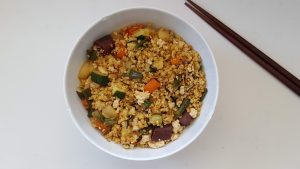
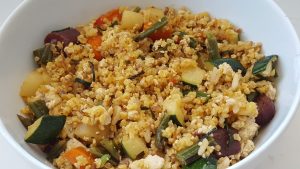
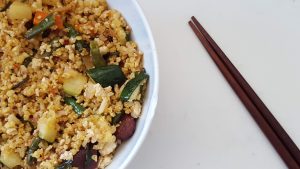
This is what I just made for lunch. Tofu, oyster mushrooms, chives, spinach, ginger, Thai curry paste, sesame oil, lime peanuts, tamari, leftover rice.